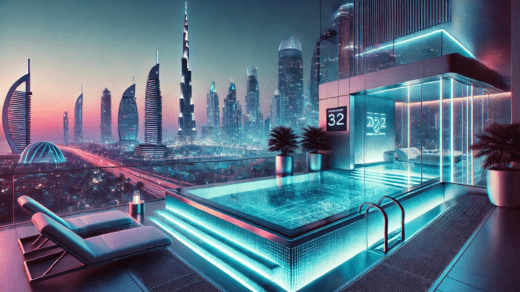Introduction
- Why Water Sanitation Matters in Ice Baths: Emphasize the importance of maintaining clean water in ice baths, especially since they’re reused over multiple sessions. Bacteria, algae, and other contaminants can thrive in cold water, and proper sanitation is crucial for safety and health.
How Ozone Generators Work
- Ozone Overview: Ozone (O₃) is a highly reactive gas composed of three oxygen atoms. It’s a powerful oxidant that can neutralize bacteria, viruses, and organic compounds by breaking down their cell walls.
- Process in Ice Bath Sanitation:
Ozone is produced by an ozone generator, which typically uses electricity to convert oxygen (O₂) into ozone (O₃). The ozone is injected into the water through a diffuser or venturi injector. As the ozone dissolves, it rapidly oxidizes contaminants in the water, neutralizing harmful microorganisms, breaking down organic waste, and leaving oxygen as a byproduct.
- Advantages:
- Highly Effective: Ozone can kill bacteria and viruses more effectively than chlorine and many other sanitizers.
- No Residual Chemicals: Ozone decomposes back into oxygen, leaving no harmful chemicals behind.
- Fast-Acting: Ozone works almost instantly upon contact with contaminants.
- Broad Spectrum: It can neutralize a wide range of pathogens, organic compounds, and odors.
How UV Systems Work
- Ultraviolet Light Basics: UV-C light (wavelength 200-280 nm) is a short-wavelength ultraviolet light that has germicidal properties, capable of damaging the DNA or RNA of microorganisms, thus preventing them from reproducing.
- Process in Ice Bath Sanitation:
Water is passed through a chamber containing a UV lamp, where the light penetrates microorganisms, inactivating them. It’s particularly effective against bacteria, viruses, and algae in the water.
- Advantages:
- Effective Disinfection: Depending on the quality of the UV bulb, UV can kill a large percentage of bacteria and viruses.
- Chemical-Free: Like ozone, UV sanitizes water without adding any chemicals.
- Safe for Equipment: Since it doesn’t rely on harsh chemicals, UV won’t cause corrosion in the bath or plumbing.
· Disadvantages:
One significant disadvantage of UV sanitization systems is the reliance on the quality of the UV bulb. The effectiveness of UV-C light in eliminating microorganisms depends on the intensity and wavelength of the bulb, typically in the range of 200-280 nm. However, not all UV bulbs meet these standards. Some manufacturers may cut corners by using low-quality or even fake UV bulbs that do not emit the proper wavelength, rendering them ineffective at killing bacteria and viruses. These inferior bulbs may produce visible light, giving the appearance that the system is functioning, but without delivering the necessary germicidal power. This makes it crucial for buyers to choose reputable manufacturers and verify the specifications of the UV bulb to ensure proper sanitation. Additionally, UV bulbs degrade over time, further diminishing their effectiveness if not replaced regularly.
Comparing Ozone and UV
- Efficiency and Spectrum:
- Ozone: Ozone works quickly and can neutralize a wider range of contaminants, including not only bacteria and viruses but also organic debris and odors. This makes it especially valuable in cold plunge settings, where skin oils, sweat, and other organic materials might accumulate.
- UV: UV is highly effective for eliminating bacteria and viruses but does not address organic debris or odors. Its sanitizing action is limited to what passes through the UV light chamber and does not sanitize the entire system or residual debris in the water.
- Residual Effects:
- Ozone: Ozone continues to sanitize the water as it diffuses, providing ongoing disinfection throughout the system. This makes it particularly well-suited for continuously running systems, like ice baths.
- UV: UV’s effect is limited to the time water is in the chamber. Once water exits, the UV’s disinfecting power stops, leaving no residual protection against recontamination.
- Maintenance:
- Ozone: Ozone generators do not generally require much maintenance
- UV: UV systems require regular cleaning of the UV sleeve and periodic replacement of the UV bulb, as bulb intensity decreases with time.
- Environmental Considerations:
- Ozone: Produces no harmful byproducts. Since ozone reverts back to oxygen, it’s environmentally friendly.
- UV: No chemicals or harmful substances are introduced, but spent UV bulbs must be disposed of properly, as they may contain small amounts of mercury.
Recommendations and Conclusion
- Ozone as a Preferred Method: Given its broader spectrum of sanitization, ability to neutralize both microorganisms and organic debris, and residual sanitizing effect, ozone may be the more effective solution for ice baths.
- Best for High-Usage Ice Baths: For commercial settings or frequent use, ozone can ensure that the water remains clean, clear, and odor-free between uses.
- Low-Chemical Option: Ozone is ideal for those seeking a powerful but environmentally friendly sanitization method that doesn’t require constant chemical intervention.
- When UV Might Be Better: UV can be a suitable option for smaller, personal ice baths or when you want a simple, chemical-free solution that works well for quick disinfection.
- Conclusion: While both ozone and UV are effective in sanitizing ice bath water, ozone offers broader protection and ongoing sanitization, making it the more comprehensive solution for long-term water cleanliness in cold plunges.

